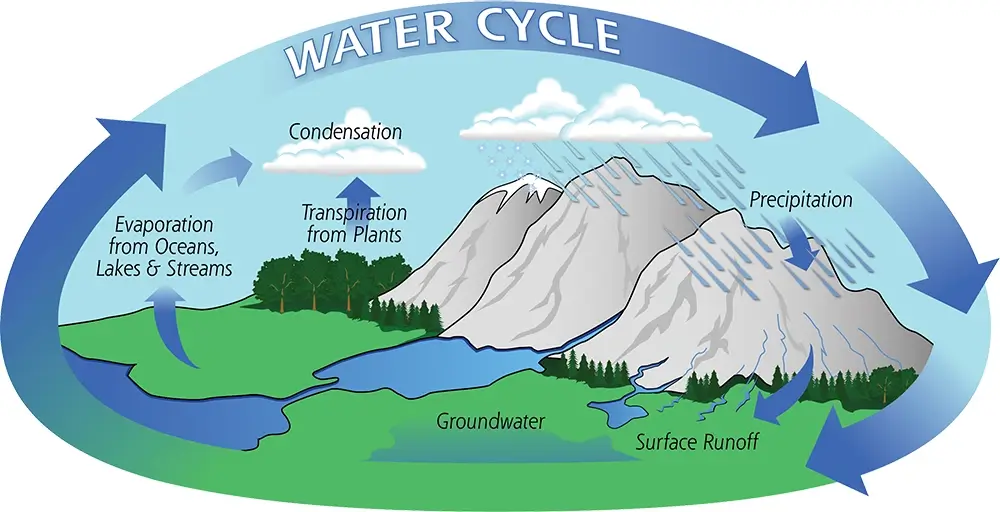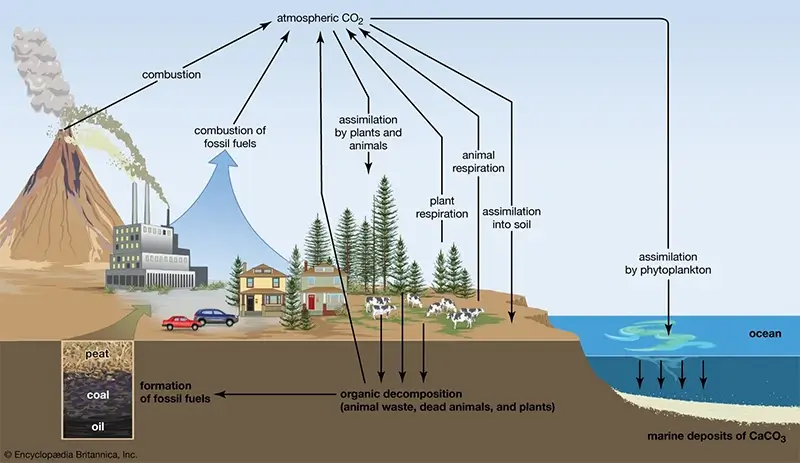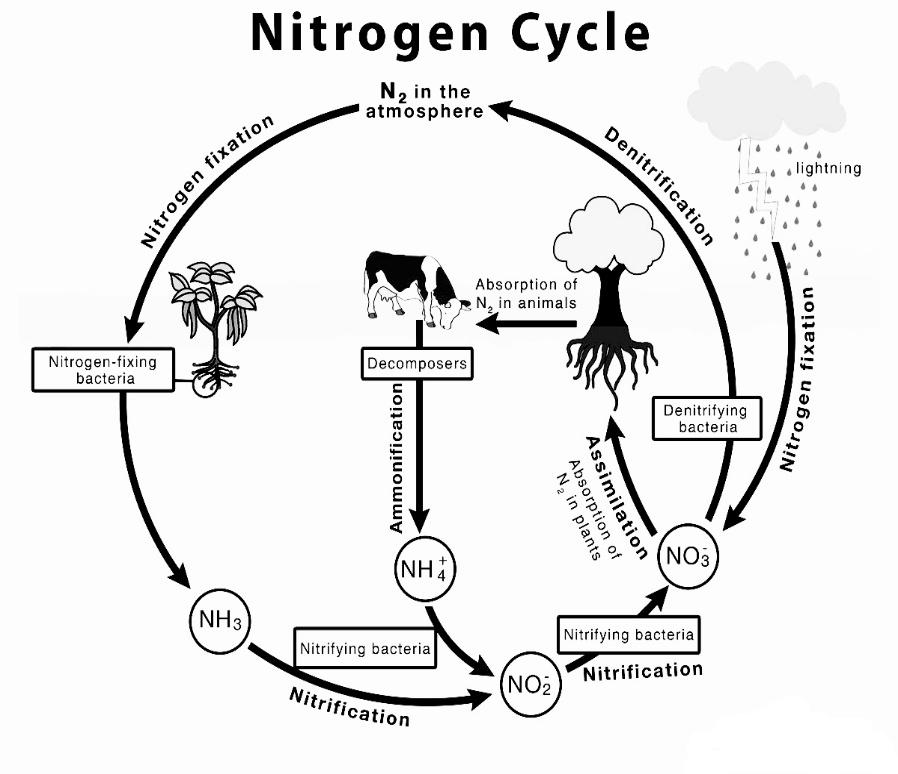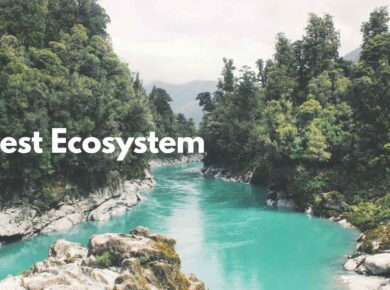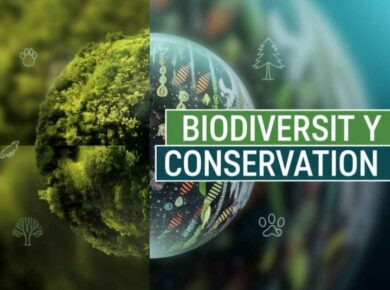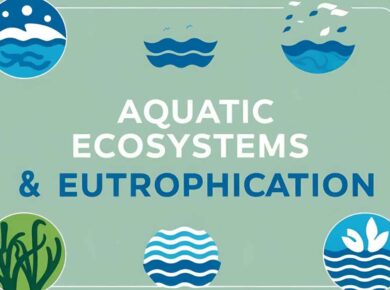Biogeocycles: Water Cycle, Carbon Cycle, Nitrogen Cycle
Mineral nutrients are always in circulation, moving from non-living to living & then back to non-living components of ecosystem in a more or less circular pattern.
Gaseous cycles: When the reservoir is atmosphere or hydrosphere for ex. Water cycle, Carbon cycle, Nitrogen cycle.
Sedimentary cycles: When the reservoir is earth crust for ex. phosphorus (Central role in aquatic ecosystem), calcium & sulfur cycle.
The Water Cycle
The Carbon Cycle
Nitrogen Cycle
- Nitrogen – an essential constituent of protein & is a basic building block of all living tissues (Constitutes 16% by weight of all proteins approximately)
- Atmospheric nitrogen is in elemental form which cannot be used directly by plants, hence needs to be fixed i.e., to be converted to ammonia, nitrites or nitrates.
Nitrogen fixation methods
- By man-made fertilizers
- By thunder & lightening
- By Cosmic Radiations
- By microorganisms (Bacteria, Blue green algae etc)
Microorganisms capable of fixing atmospheric nitrogen into ammonium ions are Azobacter, Clostridium, Rhizobium, Blue green algae (Anabaena, Spirulina)
Ammonium ions can be taken up as a source of nitrogen by some plants & are oxidized to nitrites or nitrates by nitrifying bacteria viz.
- Ammonia to Nitrites : By Nitrosomonas
- Nitrites to Nitrates : By Nitrobacter
- Nitrates synthesized by bacteria in the soil are taken up by plants & are converted into amino acids, which are the building blocks of the proteins.
- These now go to higher tropic levels & during excretion or upon death of all organisms, nitrogen is returned to soil in form of ammonia.
- In soils as well as oceans there are special denitrifying bacteria (Pseudomonas) which convert nitrates/nitrites into elemental nitrogen, which escapes to atmosphere completing the cycle.
- Amount of nitrogen fixed by man through industrial processes & through chemical fertilizers has far exceeded the amount fixed by natural cycle. As a result nitrogen has become a pollutant which leads to acid rains, eutrophication & harmful algae blooms.
🌀 Biogeocycles – 20 Key Points: Water, Carbon, and Nitrogen Cycles
Water Cycle
-
The Water Cycle involves processes like evaporation, condensation, precipitation, infiltration, and runoff.
-
Evaporation converts water from liquid to vapor due to heat from the sun.
-
Condensation forms clouds when vapor cools and turns into liquid.
-
Precipitation includes rain, snow, sleet, or hail falling to Earth.
-
Infiltration allows water to seep into the ground, replenishing groundwater.
-
Runoff channels water into rivers, lakes, and oceans.
-
This cycle is crucial for regulating climate and supporting life.
Carbon Cycle
-
The Carbon Cycle circulates carbon through the atmosphere, biosphere, oceans, and geosphere.
-
Photosynthesis by plants absorbs CO₂ and stores carbon in biomass.
-
Respiration by animals and plants releases CO₂ back into the atmosphere.
-
Combustion of fossil fuels increases atmospheric carbon.
-
Decomposition of dead organisms returns carbon to soil and air.
-
Oceans act as carbon sinks, absorbing atmospheric CO₂.
-
The cycle regulates Earth’s temperature and supports life processes.
Nitrogen Cycle
-
The Nitrogen Cycle makes atmospheric nitrogen (N₂) usable for plants and animals.
-
Nitrogen fixation by bacteria or lightning converts N₂ to ammonia (NH₃).
-
Nitrification turns ammonia into nitrites (NO₂⁻) and then nitrates (NO₃⁻).
-
Assimilation allows plants to absorb nitrates for protein synthesis.
-
Ammonification breaks down organic nitrogen back into ammonia.
-
Denitrification by bacteria converts nitrates back into N₂, returning it to the atmosphere.
-
Human activities like deforestation and industrialization disrupt the natural balance of all three cycles.
-
Climate change intensifies the water cycle, leading to extreme weather events like floods and droughts.
-
Excess nitrogen from fertilizers leads to eutrophication in water bodies, harming aquatic ecosystems.
-
The carbon cycle is closely linked to the greenhouse effect and global warming.
-
These cycles are interconnected, meaning changes in one can significantly impact the others and the overall ecosystem stability.
For more updates, explore the Environment category. Feel free to share your thoughts and comments
If you’re passionate about building a successful blogging website, check out this helpful guide at Coding Tag – How to Start a Successful Blog. It offers practical steps and expert tips to kickstart your blogging journey!

